Chinese Rank Badges
Introduction
Text-to-speech Audio
From 1391 to 1911, a scholar’s status in the meritocracy of the Imperial Court was shown in the rank badges, also known as mandarin squares, or insignia squares, worn on his jacket. A male civil servant earned his badge by passing grueling tests. All three names indicate the embroidered or woven squares worn by civil and military officials who worked hard to earn this recognition. Rank badges are still some of the finest embroideries of gold thread on silk ever done anywhere in the world. We are lucky to have these beautiful works of embroidered art. Few of these exist anymore because most imperial rank badges were burned when the revolutionary communist government came into power in 1949 under Mao Zedong. Because of the communist revolution in China, possessing articles from the old imperial regime could have resulted in death...
· Nine civil ranks and nine military ranks existed in the ancient imperial rank badge system...
· Each civil rank was represented by a particular bird...
· To earn the first civil rank, a man had to pass an exhaustive exam. If he passed, he and his family could wear the paradise flycatcher badge of the lowest ninth rank. To rise to higher ranks, he had to pass more difficult tests...
· For military badges, the man had to pass strenuous physical tests. He and his family would then wear badges with embroidered animals...
· Both civil and military badges contain other symbols...
Do you see a symbol that is in all of them?
· The sun is a symbol for the Chinese emperor who was believed to have a mandate from heaven...
· The bird and animal symbols all face the sun symbol to honor the emperor...
· Insignias belonging to men face to the left; those worn by women face to the right. When a man and his wife sat next to each other, the birds or animals faced each other...
Please click on the first photo to view the slide show...
Images
The Golden Peacock is easily identified by the eyes of his peacock tail feathers.
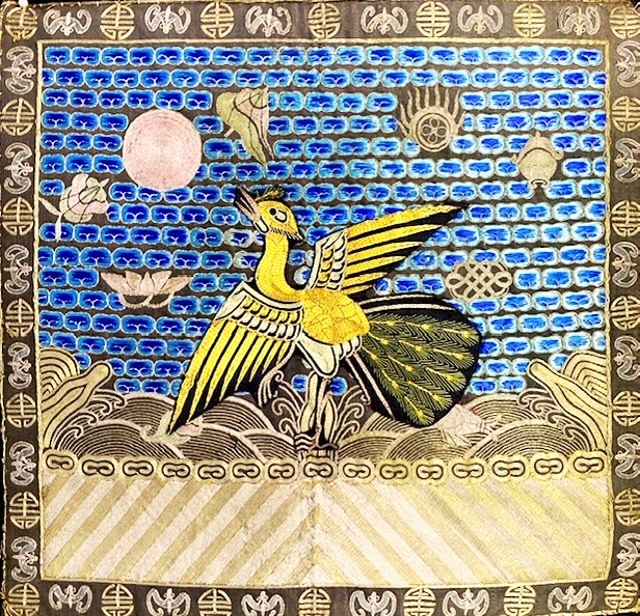
Wives wore the badges shown here on the left and men wore the badges on the right so that the birds faced each other when the couple sat next to each other in court.
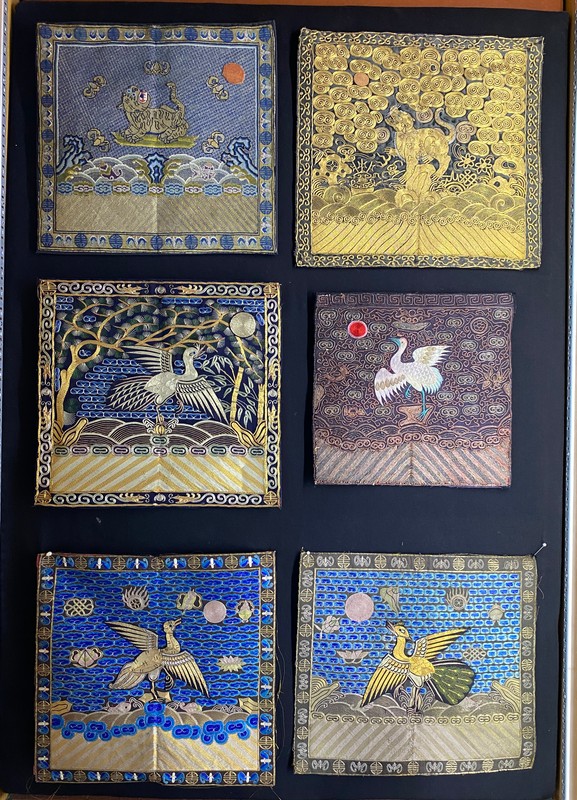
Buddhist symbols of Eight Precious Things
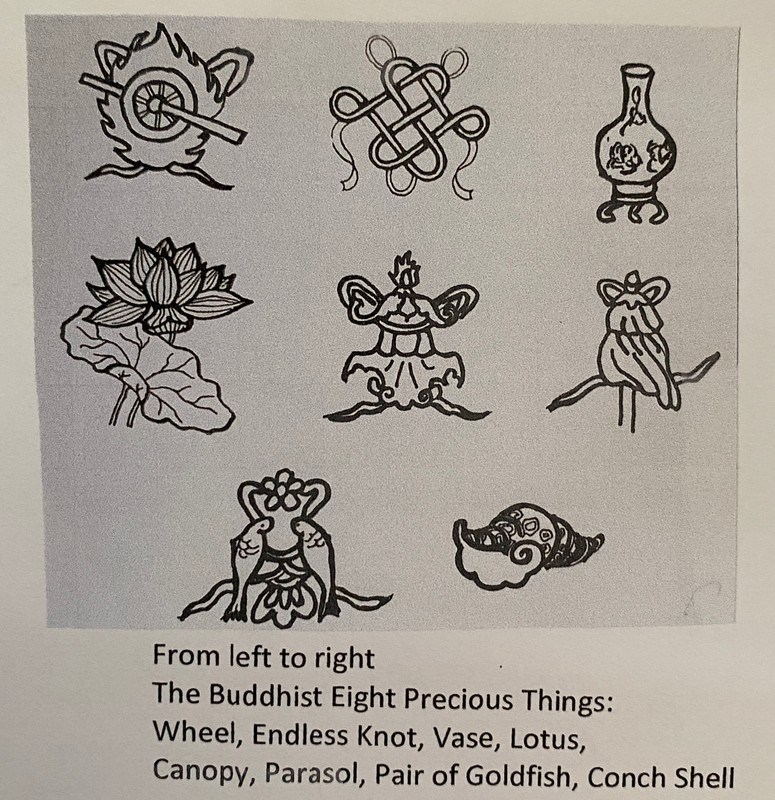
The Taoist (Daoist) symbols represent the objects carried by the Eight Immortals.
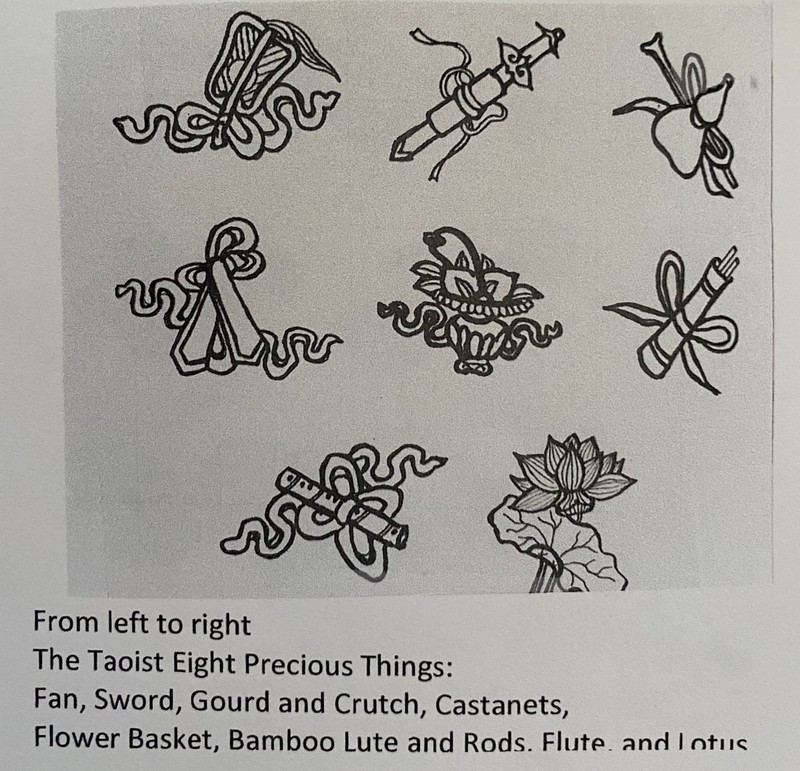
Specific Chinese characters were thought to bring good fortune.
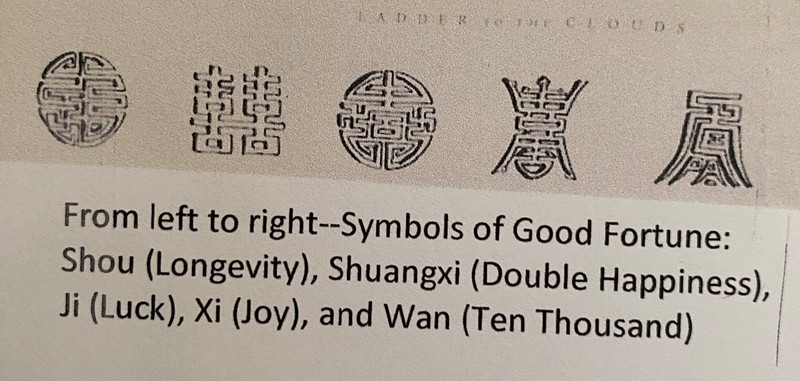
This ancestor scroll depicts a man wearing a rank badge and elaborate collar and Imperial Court beads.
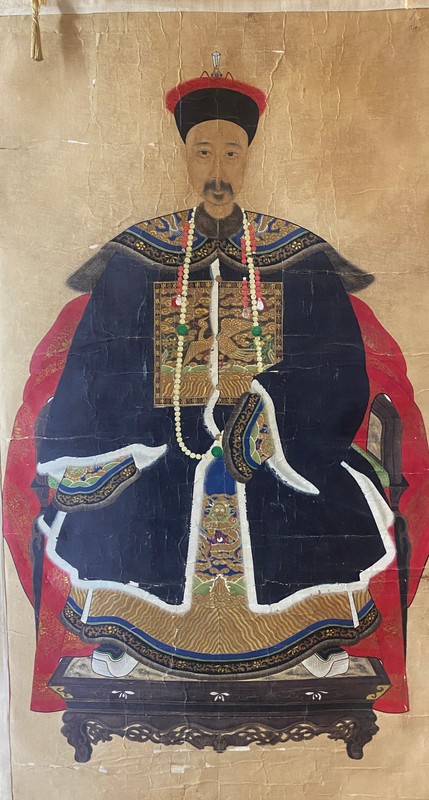
This gauze summer jacket with a crane rank badge was for a 1st rank master scholar.
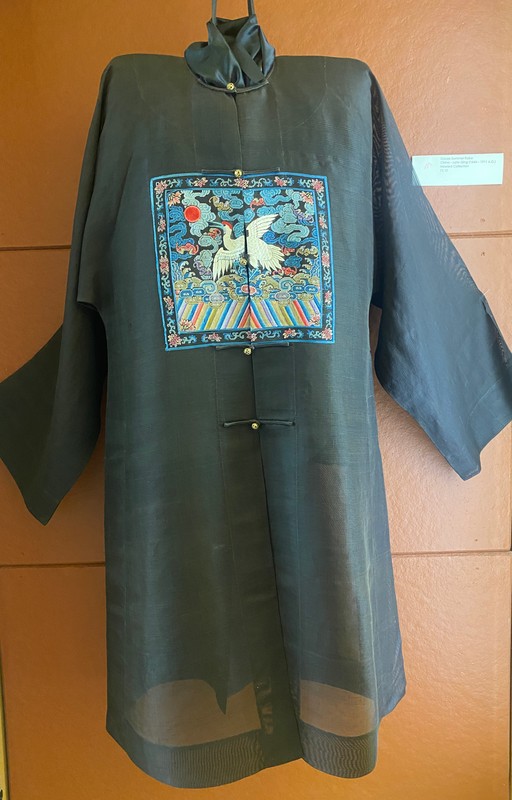
Close-up of the 1st Rank crane with the red crown
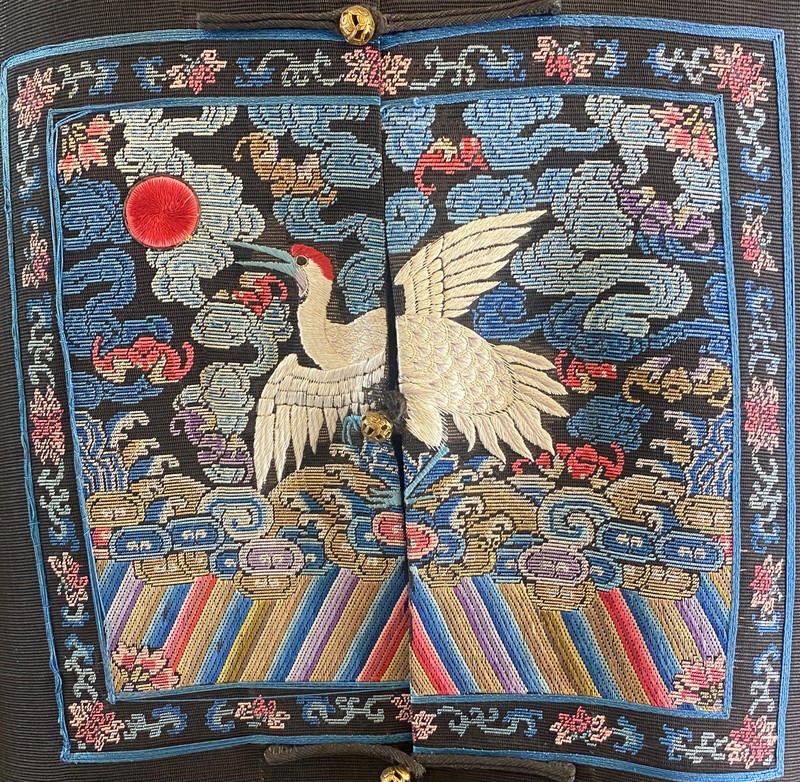
This tiger facing the right belonged to the wife of a 4th rank military official. 76.01
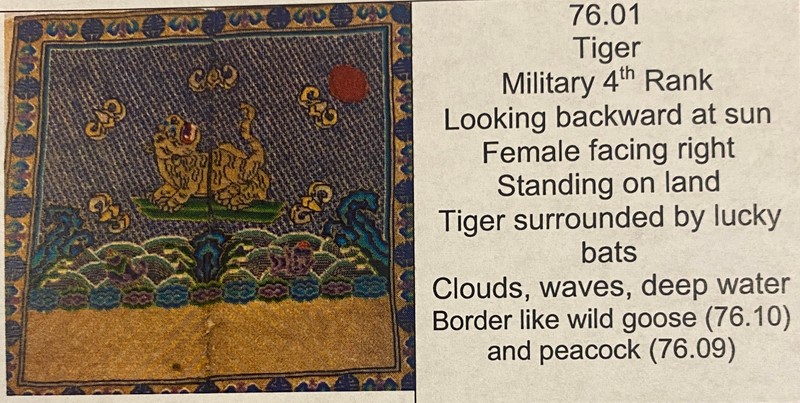
An important 3rd rank military officer wore this golden-thread leopard badge.
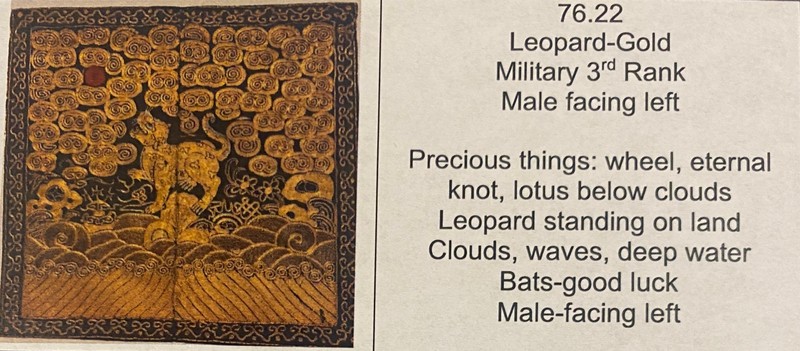
The pine tree and bamboo bring long life and many sons to the wearer of this badge.
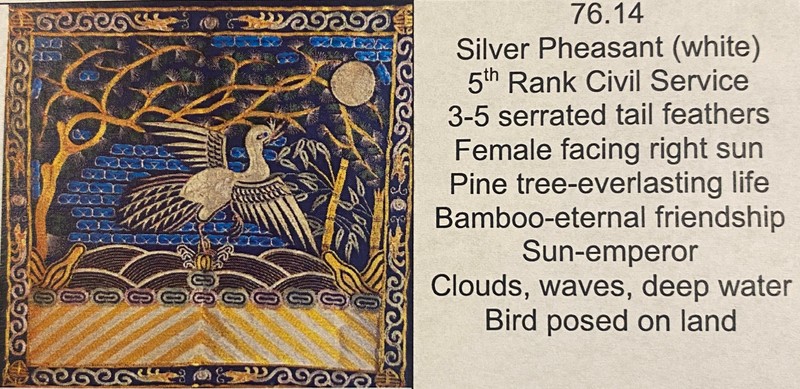
Green legs distinguish this bird as an egret rather than a crane.
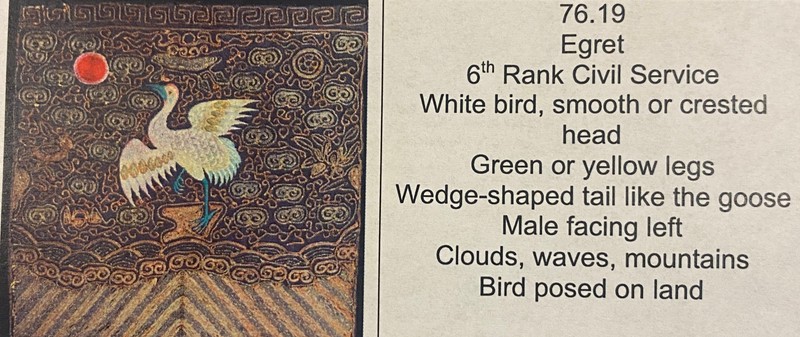
Six Buddhist Precious Things are floating in the sky, while the fish and conch can be seen in the water.
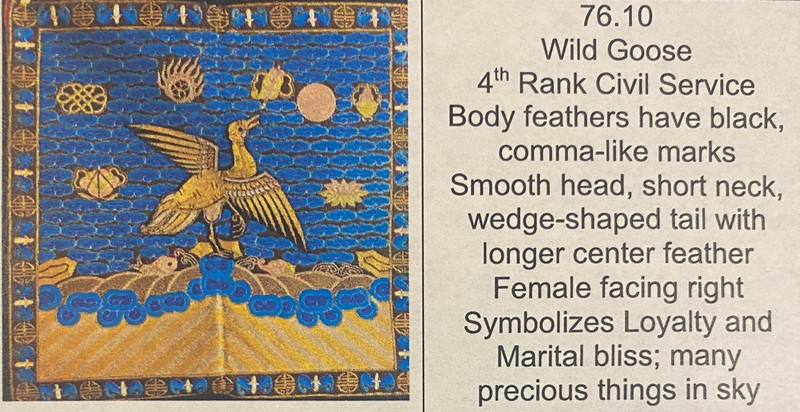
This golden peacock is surrounded by Precious Things as well.
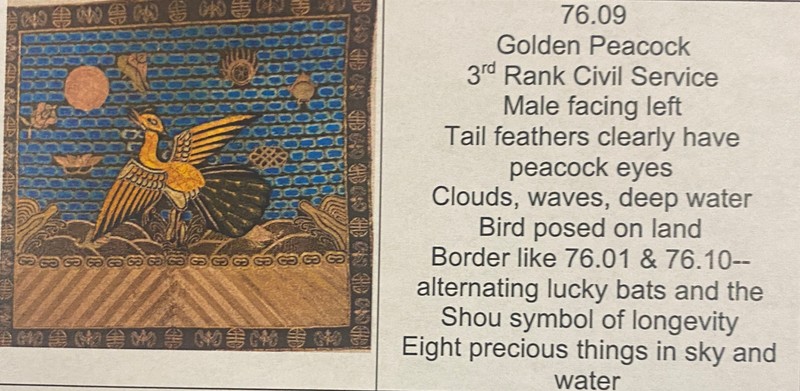
Many common symbols appear in Chinese art and literature.
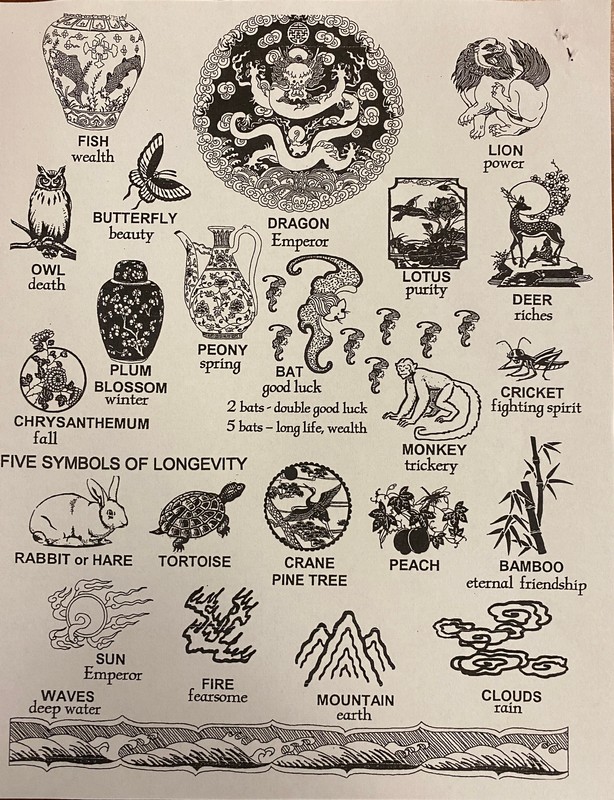
This chart shows the various birds or animals associated with each rank of civil or military badges.
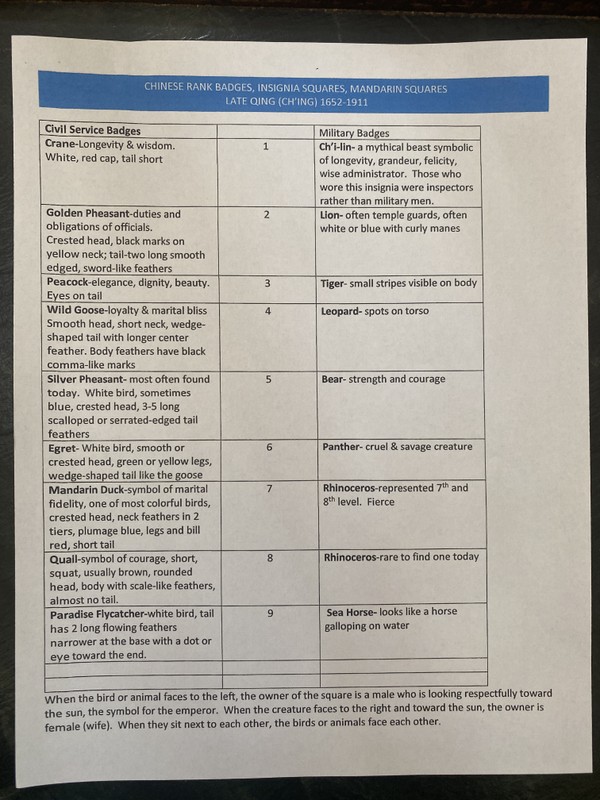
Backstory and Context
Text-to-speech Audio
Beginning in the Han dynasty (206 BCE – 220 CE), administrators of civil service exams sought to find the best candidates for the vast bureaucracy that governed China. Scholars first took local tests; if they passed, they moved on to the three-day exams in the capital. For the one percent of test takers who passed the earlier exams, the final challenge was to pass the exams in the imperial palace itself. The exams evolved over the centuries but always included memorizing the classics of Chinese literature, especially Confucianism. Beginning in the Tang dynasty (618 – 906 CE), students had to demonstrate proficiency in writing and calligraphy, formal essay writing techniques, classic literature, mathematics, legal and government matters, poetry, and clear and coherent speaking. Each dynasty thereafter added extra layers of difficulty but expanded the number of participants to meet the greater demands of the growing Chinese government...
The tests in the provinces took three days. Scholars would be searched and, if found with materials to cheat, would be expelled and not allowed to take a test again. Each testing cubicle had three boards to be arranged as a chair and desk or bed, as needed. The cubicle remained open so that proctors could observe the test-takers’ behavior. Once the results were announced, those who passed were invited to a special banquet to celebrate; those who failed would try again next time. The average age of those passing the second level was 30, and for the third level, 40...
This system of promotion through examination of abilities, or meritocracy, served to reduce the bribery and graft in government circles. It also placed enormous value on education, a view still important in China. The system also created a compliant section of society because a fundamental principal of Confucianism was a sense of duty. However, the uniformity of the exam system encouraged memorization and conformity, rather than imaginative or creative thinking. As industrialization and scientific advances spread throughout the western nations, China fell behind because of their emphasis on classical education. As a result, after one thousand years of tradition, in 1905, the Qing leaders abolished the civil service exams, and since then, China has excelled in technology and science...
Cite This Entry
STW on behalf of Assistance League of Long Beach. "Chinese Rank Badges." Clio: Your Guide to History. January 2, 2024. Accessed March 30, 2025. https://theclio.com/entry/171765/tour/9
Sources
"Chinese Rank Badges." The Journal of Antiques and Collectibles/The Social Platform for Antiquers, Collectors, and Enthusiasts. January 15, 2005. Accessed September 18, 2023. https://journalofantiques.com/features/chinese-rank-badges/.
Dine, Susan Michelle. "Qing-Dynasty Rank Badges at the University of Michigan." Exchange: Qing-dynasty rank badges at the University of Michigan. March 18, 2022. Accessed September 18, 2023. https://exchange.umma.umich.edu/resources/26228.
"Unmistaken Identity: a Guide to the Rank Badges of Ancient China." CHRISTIE'S. September 22, 2022. Accessed September 18, 2023. https://www.christies.com/features/Unmistaken-identity-a-guide-to-tthe-rank-badges-of-Chinese-Imperial-officials-12106-1.aspx.
Jackson, Beverly. Hugus, David. Ladder to the Clouds: Intrigue and Tradition in Chinese Rank. Berkeley, California. Ten Speed Press, 1999.
“The Confucian Classics and the Civil Service Examinations.” Asia for Educators, Columbia University. 2023. Accessed October 4, 2023. http://afe.easia.columbia.edu/cosmos/irc/classics.htm
Cartwright, Mark. "The Civil Service Examinations of Imperial China." World History Encyclopedia. 08 Feb 2019. Web. Accessed 03 Oct 2023. https://www.worldhistory.org/article/1335/the-civil-service-examinations-of-imperial-china/.
Howard Collection 76.09
Howard Collection
Ladder to the Clouds p. 207
Ladder to the Clouds p. 206
Ladder to the Clouds p. 212
Asian Art Collection
Howard Collection 75.10
Howard Collection 75.10
Howard Collection 76.01
Howard Collection 76.22
Howard Collection 76.14
Howard Collection 76.19
Howard Collection 76.10
Howard Collection 76.09
Howard and Asian Art Docent Study Materials
Info collected from Ladder to the Clouds

